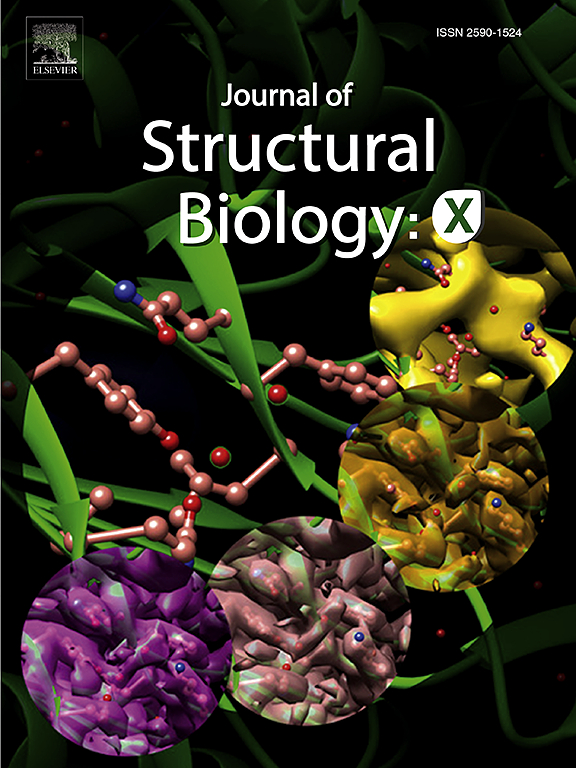Calcium carbonate deposition in the spicules of the sponge Heteropia glomerosa (Porifera, Calcarea)
IF 2.7
3区 生物学
Q3 BIOCHEMISTRY & MOLECULAR BIOLOGY
引用次数: 0
Abstract
We investigated the biomineralization process of calcium carbonate deposition in the spicules of the calcareous sponge Heteropia glomerosa (Porifera, Calcarea). The finely polished spicules, composed of Mg-calcite, present a pattern of concentric lines spaced 400 nm apart when observed by scanning electron microscopy. We showed by electron backscattered diffraction that the whole spicule length has the same crystallographic orientation. Still, misorientation of up to 1.8° in adjacent regions (∼ 2 µm) and a continuous increase in the misalignment of up to 4.5° in regions separated by 300 µm were present. The sponge cells (mainly sclerocytes and pinacocytes) near the mineralization zone contain a high number of vesicles rich in calcium, which could be involved in the spicule biomineralization. We showed by electron and ion microscopies that the spicule growth occurs through the addition calcium carbonate granules, which form near the membrane of the sclerocyte, the cell responsible for biomineralization. The granules were deposited layer by layer on the surface of the spicule, increasing the biomineral thickness. Domains of 1–3 µm containing facets partially connected and surrounded by organic material were observed in an intermediate stage of the spicule growth. Misorientation between these domains was approximately 2°, similar to the misorientation obtained by electron backscattered diffraction, indicating that the spicule is formed by the addition of granules fusing in a predominant orientation.

海绵小球异视(Porifera, Calcarea)的针状物中的碳酸钙沉积。
我们研究了碳酸钙沉积在钙质海绵Heteropia glomerosa (Porifera, Calcarea)针状体中的生物矿化过程。由镁方解石组成的精细抛光针状体在扫描电镜下呈现出间距为400 nm的同心线模式。电子背散射衍射结果表明,整个针状体长度具有相同的晶体取向。尽管如此,在相邻区域(~ 2µm)存在高达1.8°的取向偏差,并且在间隔300 µm的区域存在高达4.5°的连续增加的取向偏差。矿化带附近的海绵细胞(主要是硬化细胞和松状细胞)含有大量富含钙的囊泡,这些囊泡可能参与了针状生物矿化。我们通过电子和离子显微镜显示,针状生长是通过添加碳酸钙颗粒发生的,碳酸钙颗粒在硬细胞膜附近形成,硬细胞负责生物矿化。颗粒一层一层地沉积在针状体表面,增加了生物矿物的厚度。在针状物生长的中间阶段,观察到1-3 µm的区域,其中包含部分连接并被有机物质包围的切面。这些畴之间的取向偏差约为2°,与电子背散射衍射得到的取向偏差相似,表明颗粒是由在优势取向上融合的颗粒添加而形成的。
本文章由计算机程序翻译,如有差异,请以英文原文为准。
求助全文
约1分钟内获得全文
求助全文
来源期刊

Journal of structural biology
生物-生化与分子生物学
CiteScore
6.30
自引率
3.30%
发文量
88
审稿时长
65 days
期刊介绍:
Journal of Structural Biology (JSB) has an open access mirror journal, the Journal of Structural Biology: X (JSBX), sharing the same aims and scope, editorial team, submission system and rigorous peer review. Since both journals share the same editorial system, you may submit your manuscript via either journal homepage. You will be prompted during submission (and revision) to choose in which to publish your article. The editors and reviewers are not aware of the choice you made until the article has been published online. JSB and JSBX publish papers dealing with the structural analysis of living material at every level of organization by all methods that lead to an understanding of biological function in terms of molecular and supermolecular structure.
Techniques covered include:
• Light microscopy including confocal microscopy
• All types of electron microscopy
• X-ray diffraction
• Nuclear magnetic resonance
• Scanning force microscopy, scanning probe microscopy, and tunneling microscopy
• Digital image processing
• Computational insights into structure
 求助内容:
求助内容: 应助结果提醒方式:
应助结果提醒方式:


